What is Citizen Science?
Citizen Science is the collection of scientific data by individuals who are not professional scientists. They are prepared for their work as citizen scientists by professional biologists from the land management agency. These projects are on-going and consist of a network of volunteers. Citizen Science networks are very important. The citizen science monitoring programs would not be the success it is without the participation of citizen scientists. Without these dedicated volunteers, too few data would be collected to accomplish research objectives. Much of what has been learned about the monarch butterfly and its migration is the result of citizen science projects.
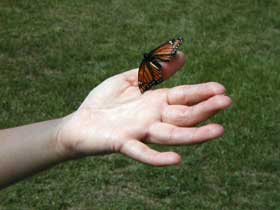
Releasing a tagged Monarch. Photo by Anne Okonek.
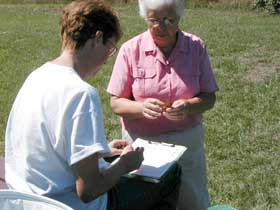
Two volunteers record data on a monarch butterfly they recently tagged. Photo by Anne Okonek.
Monarch Larva Monitoring Project (MLMP)
The Monarch Larva Monitoring Project involves citizen scientists from across the United States and Canada. This program was developed by researchers at the University of Minnesota to collect long-term data on larval monarch populations and milkweed habitat. The focus is on monarch distribution and abundance during the breeding season in North America.
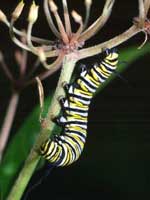
Photo by Mike Higgins.
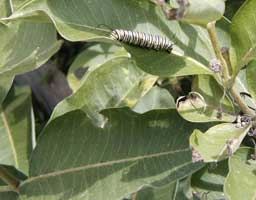
Photo by Anne Okonek.
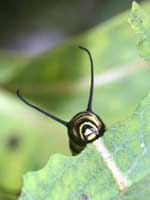
Photo by Mike Higgins.
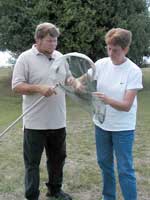
Netted monarch. Photo by Anne Okonek.
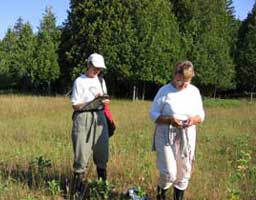
Monarch Larva Monitoring Program volunteers counting the number of monarch eggs and larvae on milkweed. Photo by Janet Ekstrum.
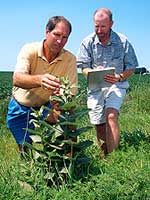
Researchers inspecting a milkweed plant. Photo by USDA.
Monarch Watch
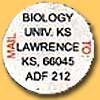
Monarch tags are tiny, round stickers made of polypropylene. They are 9mm in diameter, a little larger than a hole-punch, and account for about 2 percent of a butterfly’s weight.
Monarch Watch is a citizen-science project based at the Kansas Biological Survey, University of Kansas. This project involves volunteers across the United States and Canada who tag individual butterflies to assist scientists in studying and monitoring monarch populations and the fall migration. The tagging program helps answer questions about the geographic origins of monarchs that reach Mexico, the timing and pace of the migration, mortality during migration, and changes in geographic distribution.
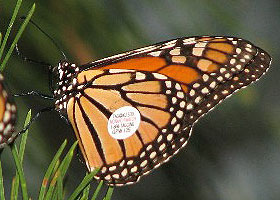
A tagged Monarch. Photo by Mark Garland.
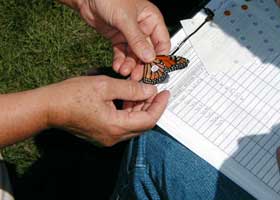
Recording data for a tagged Monarch. Photo by Anne Okonek.
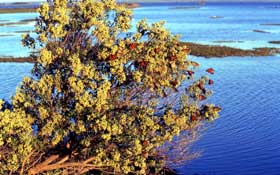
Monarchs bask just after sunrise on groundsel-tree (Baccharis halimifolia) at the edge of Oyster Bay in the Chincoteague National Wildlife Refuge, Virginia, where they roosted for the night. Photo by Denise Gibbs.
During the fall monarch migration, monarchs congregate at several shoreline locations in North America, waiting for a gentle northerly breeze to help carry them across open water. Volunteers have been monitoring monarchs for over ten years at Peninsula Point in Michigan, Cape May Bird Observatory in New Jersey and Chincoteague National Wildlife Refuge in Virginia.
In addition to tagging and migration monitoring, Monarch Watch has begun a monarch Waystation Program. Waystations are flower gardens or natural areas with milkweeds that act as host plants for monarch larvae and nectar plants that serve as energy sources for adult monarchs.
Journey North
Journey North is an on-line global study of wildlife migration and seasonal change. Students K-12 report their own field observations of the northern migration of a variety of wildlife species including the monarch butterfly.
Project Monarch Health
Researchers at the Institute of Ecology at the University of Georgia are studying monarch health as part of a national citizen-science program. The protozoan parasite, Ophryocystis elektroscirrha, does not affect humans but it can hinder a monarch butterfly’s growth and survival. Volunteers capture live butterflies and collect parasite spores to help scientists map the locations and amounts of parasitism and disease in monarch butterfly populations.
North American Butterfly Association Butterfly Counts
During the annual North American Butterfly Association (NABA) Butterfly Counts volunteers in the United States, Canada, and parts of Mexico conduct a one-day census of all butterflies sighted within a 15-mile diameter circle. NABA compiles and publishes the results in annual reports that provide information about the geographical distribution and relative population sizes of the species counted. The information can be used to monitor butterfly populations and study the effects of changes in weather and habitats.
Monitoring Areas
The citizen science monitoring programs includes areas all across North America. There are over 700 monitoring locations participating in the Monarch Larva Monitoring Program in the Eastern United States and Canada. Currently Monarch Watch has over 1,250 Waystations. Their goal is to have a total of 10,000 Waystations over the next three years.
Select the points on the map below to see more information about some of the monitoring areas.
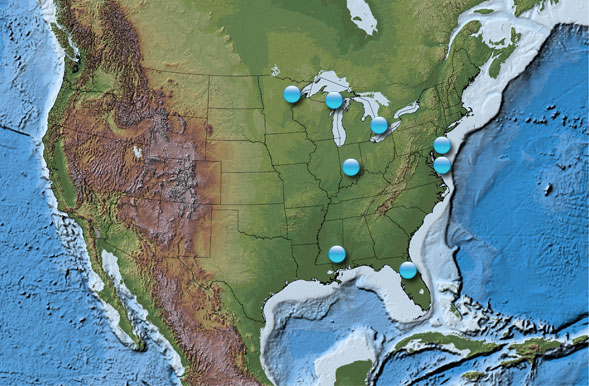
Monarch Butterfly Monitoring Area Locations. Base map source: USGS National Atlas.

